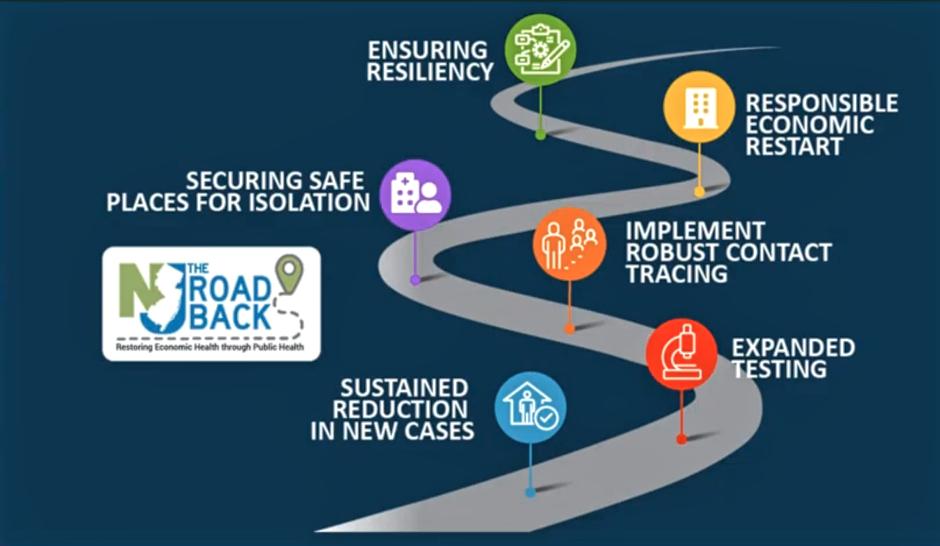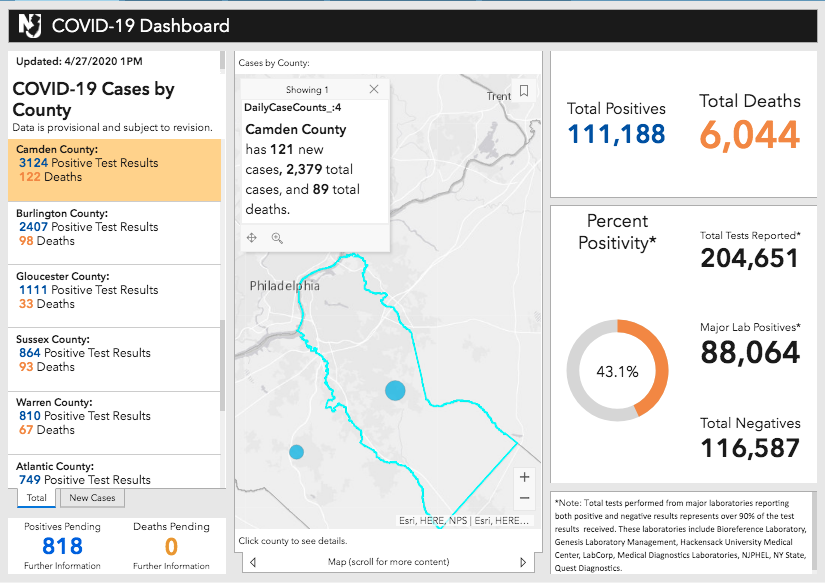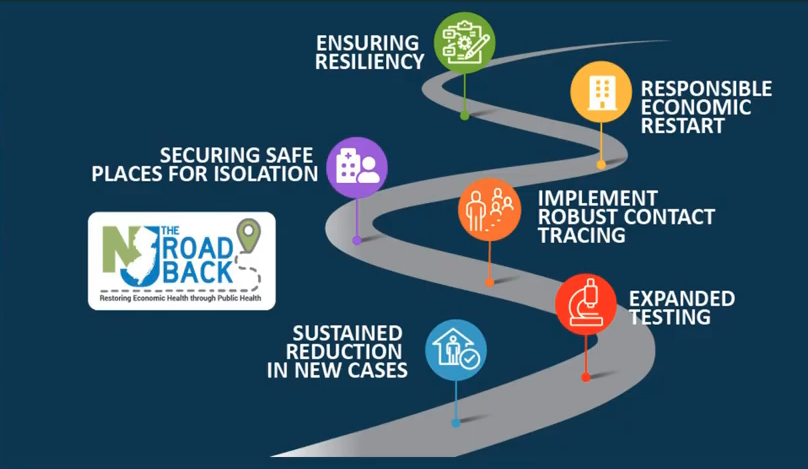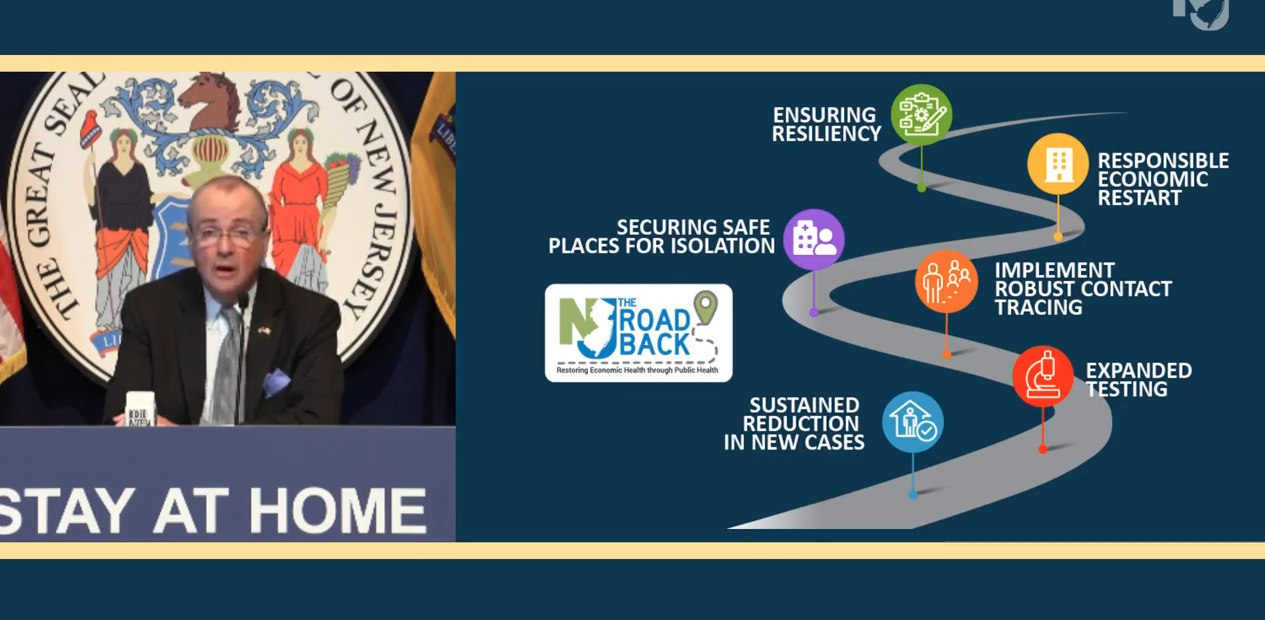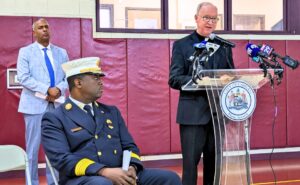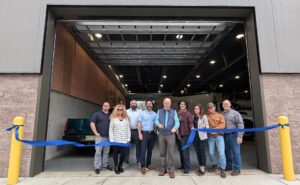The governor’s six-point plan to restart New Jersey includes guidance on healthcare, testing, contact tracing, quarantining, the economy, and future capacity to weather a pandemic, as the state death toll exceeds 6,000 people.
By Matt Skoufalos | April 27, 2020
Another 2,146 New Jersey residents have tested positive for novel coronavirus (COVID-19), bringing the statewide total to 111,188 cases, Governor Phil Murphy reported Monday.
Sadly, the state absorbed another 106 COVID-19-related deaths, bringing the total number of lives lost in the pandemic to 6,044, Murphy said.
Across the state, 6,407 residents are hospitalized with a case of COVID-19 or while awaiting confirmation of their status.
Of those, 1,801 are in critical or intensive care and 1,303 are on ventilators.
Five hospitals were on divert last night, said New Jersey Health Commissioner Judy Persichilli; two in North and three in Central Jersey.
In the past 24 hours, New Jersey hospitals have admitted 314 new patients and discharged 480 others, either to lower-acuity care settings or to their homes.
Finally, another 75 people are receiving care at one of New Jersey’s field medical stations; 346 have been treated at those sites so far, Persichilli said.
Of the total cases in the state, 16,277 are connected with a long-term care site, she said.
The Road Back
The biggest news of the day was Murphy’s unveiling of “The Road Back,” the principles of his plan to reopen the state.
The six-point program outlines New Jersey’s need for diminished COVID-19 cases, expanded testing and contact tracing, safe quarantine locations for those who need them, and progress towards building capacity for its healthcare system to absorb a recurrence of the virus (or others) before restarting the economy.
“That’s the order in which we must proceed,” Murphy said. “Before we reopen non-essential stores and businesses, before we can reopen our parks, or before we allow in-person dining in our restaurants, among any host of other activities, people need to know, first and foremost, that their health will be safeguarded from COVID-19.”
Informed by his perspective that “public health creates economic health,” Murphy spoke about the need to address the social inequalities that he said COVID-19 “did not create… but it laid them bare.”
“So this is also our opportunity to help close those gaps,” the governor said.
The plan establishes the following requirements for reopening the state.
1. A two-week trend of sustained decreases in new COVID-19 cases, hospitalizations, “and other key metrics reflecting a decreasing burden of disease.”
“We cannot look at just one day or one snapshot in time and say we’ve succeeded or failed,” Murphy said. “We will need to look across a length of time, and to not be distracted by statistical noise.”
2. Broadly expanded COVID-19 testing.
Murphy said New Jersey must double its testing capacity by the end of May, and create “a flexible testing plan” with walk- and drive-up sites, potentially in-home test kits, and the facilities to process results quickly.
Priority will still be given to essential workers, healthcare workers, and vulnerable populations, “and we will ensure those who test positive will be linked to a health care provider,” Murphy said.
3. Robust contact tracing.
Murphy described needing “an army of contact tracers” to follow up on confirmed COVID-19 cases, which could be as many as 7,000 people at a rate of as many as 80 per 100,000 patients in a state of 8.8 million people.
He suggested that there may be technological solutions to cut back those numbers or otherwise improve the efficiencies of the contact tracing process.
4. Safe quarantine locations for COVID-19-positive residents.
Murphy and Persichilli have previously spoken about the possibility of keeping open New Jersey field hospital sites to house people who have nowhere else to live safely while they recover from the virus. The state “must also be prepared to support these people with wrap-around services, as needed,” the governor said.
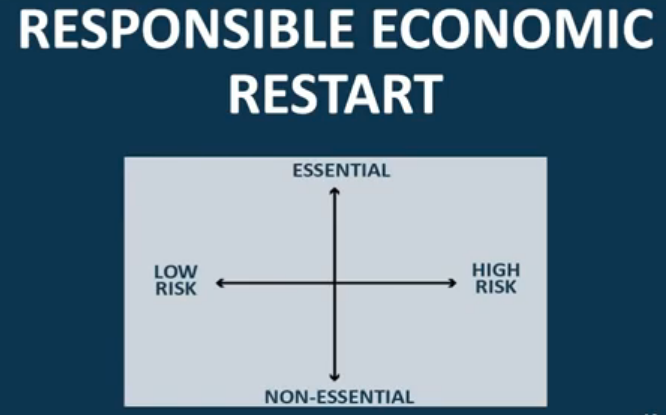
A “responsible economic restart” for New Jersey prioritizes essential and low-risk businesses, Gov. Phil Murphy said. Credit: NJ Pen.
5. Responsibly restarting the economy.
On Tuesday, Murphy will announce his Restart and Recovery Commission, which comprises “economists, business leaders, labor leaders, and health care experts,” who will “balance multiple competing needs to ensure we arrive at equitable decisions that work for every community in our state.”
In addition to seeking “any and all available federal funds and programs to support our recovery,” Murphy said the commission will reopen businesses beginning with those essential to the economy and that can operate safely “until we achieve a fully functioning and open economy.”
The governor said social distancing measures, including work-from-home flexibility and wearing face coverings in public, likely will not be relaxed any time soon.
“We will move as quickly as we can, but as safely as we must,” Murphy said. “This virus is now among us, and our task will be to contain it as best we can. But, with our public-health protocols firmly in place, and with our healthcare system prepared, you should not fear heading back to work or elsewhere.”
Murphy said that businesses shouldn’t expect “a last-in-first-out strategy” for economic reopening, but will follow a mechanism of low risk and high essential nature. For example, “concerts,” he said, “are not going to be any time soon.”
6. Improved resiliency.
Murphy said New Jersey hospitals and the state on the whole should be building capacity to absorb a second wave of viral outbreaks, including sourcing personal protective equipment (PPE) to ventilators and staff sufficient to address it across levels of care, from hospitals to freestanding clinics to individual practices.
Resiliency also includes caring for those vulnerable to healthcare disparities, and the governor said that “no one will be left unprotected because of racial or socio-economic status.
“COVID-19 showed no favorites in ravaging our state, and neither will we in preparing for the next wave,” Murphy said.
“We must use this window of opportunity to fill gaps and fortify our health care system,” the governor said. “We cannot find ourselves in another situation where we must rely on the federal government, or our corporate and philanthropic partners, to source what we need. We must build our resiliency now.”
Murphy said the plan his administration will create can provide a reference for future pandemic policy guidance and can be “hand[ed] off to future administrations,” including “the framework for the dozens of executive orders and other processes necessary for facing a global pandemic head on and emerging stronger from it.”
“We cannot think of COVID-19 as a one-and-done,” the governor said. “Whether we are hit with a rebound of COVID-19, or a different strain, or an altogether new virus outbreak, we have learned valuable lessons that we would be foolish to ignore.”
“Pandemics aren’t something in a far-off place that we just read about in the news anymore,” Murphy said. “We are living it right here in one of the most advanced states in the most advanced nation in the world.”
The governor said New Jersey’s plans “want to be largely in harmony” with the plans of neighboring states in its northeastern coalition, but cautioned that it “will never necessarily” be in lockstep with the decisions made in other states.

